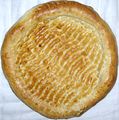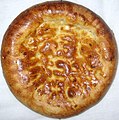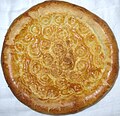
Naan is a leavened, oven-baked or tawa-fried flatbread, which is found in the cuisines mainly of Afghanistan, South Asia, Central Asia, Indonesia, Malaysia, Myanmar, and the Caribbean.

Lavash is a thin flatbread usually leavened, traditionally baked in a tandoor or on a sajj, and common to the cuisines of South Caucasus, West Asia, and the areas surrounding the Caspian Sea. Lavash is one of the most widespread types of bread in Armenia, Azerbaijan, Iran and Turkey. The traditional recipe can be adapted to the modern kitchen by using a griddle or wok instead of the tonir.

Barbari bread is a type of yeast leavened flatbread. It is one of the thickest flat breads and is commonly topped with sesame or black caraway seeds. A notable characteristic of the bread is its top skin that is similar to pretzels or lye roll's skin due to the Maillard reaction that occurs during baking. Before baking it is glazed with a mixture of baking soda, flour and water. It is widely known as Persian flatbread in United States and Canada.
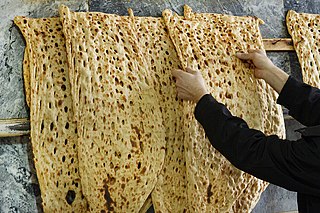
Sangak or nân-e sangak is a plain, rectangular, or triangular Iranian whole wheat leavened flatbread.

A flatbread is a bread made with flour; water, milk, yogurt, or other liquid; and salt, and then thoroughly rolled into flattened dough. Many flatbreads are unleavened, although some are leavened, such as pita bread.

Indian breads are a wide variety of flatbreads and crêpes which are an integral part of Indian cuisine. Their variation reflects the diversity of Indian culture and food habits.
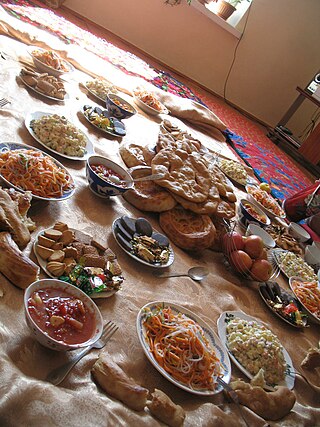
Central Asian cuisine has been influenced by Persian, Indian, Arab, Turkish, Chinese, Mongol, African, and Russian cultures, as well as the culinary traditions of other varied nomadic and sedentary civilizations. Contributing to the culinary diversity were the migrations of Uyghur, Slav, Korean, Tatar, Dungan and German people to the region.

Uzbek cuisine shares the culinary traditions of peoples across Central Asia. There is a great deal of grain farming in Uzbekistan, so breads and noodles are of importance, and Uzbek cuisine has been characterized as "noodle-rich". Mutton is a popular variety of meat due to the abundance of sheep in the country and it is a part of various Uzbek dishes.
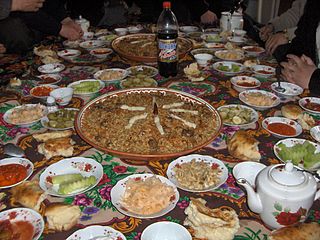
Tajik cuisine is a traditional cuisine of Tajikistan, and has much in common with Russian, Afghan, Iranian and Uzbek cuisines. Plov (pilaf), also called osh, is the national dish in Tajikistan, as in other countries in the region. Green tea is the national drink.

Turkmen cuisine, the cuisine of Turkmenistan, is similar to that of the rest of Central Asia. Turkmen seminomadic culture revolved around animal husbandry, especially sheep herding, and accordingly Turkmen cuisine is noted for its focus on meat, particularly mutton and lamb. One source notes,
The nomadic past has left a very noticeable trace in Turkmen cuisine - the basis of the diet is meat: lamb, meat of gazelles, non-working camels, wild fowl, chicken. Beef is consumed much less frequently because this food appeared on the table much later, Turkmens don't eat horse meat at all.

Uyghur cuisine is the cuisine of the Uyghur people, which are mainly situated in the autonomous region of Xinjiang.
Awadhi cuisine is a cuisine native to the Awadh region in Northern India. The cooking patterns of Lucknow are similar to those of Central Asia, the Middle East, and Northern India and western India with the cuisine comprising both vegetarian and non-vegetarian dishes. The Awadh region has been influenced by Mughal cooking techniques, and the cuisine of Lucknow bears similarities to those of Central Asia, Kashmir, Punjab and Hyderabad. The city is also known for its Nawabi foods.

Sheermal, also spelled shirmal, is a saffron-flavored traditional flatbread eaten in Iran and the Indian subcontinent. The word sheermal is derived from the Persian words شیر meaning milk, and مالیدن meaning to rub. In a literal translation, sheermal means milk-rubbed. Found by Persians in Old Dhaka, it was introduced to North India by the Mughal emperors during the medieval period. It became a delicacy of Lucknow, Hyderabad and Aurangabad. It is also part of the Awadhi cuisine and is enjoyed in Old Bhopal and Pakistan.
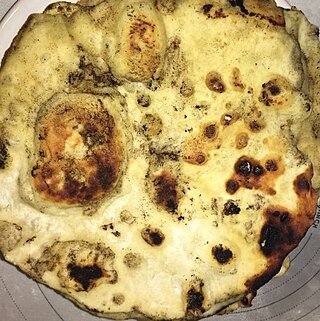
Laffa, also known as lafa or Iraqi pita, is a large, thin flatbread in Israeli cuisine with an Iraqi Jewish origin. Laffa is a simple bread that is traditionally vegan and cooked in a tannur (tandoor) or taboon oven. It is most often used to wrap falafel, kebab, and shawarma to make sandwiches, to dip in hummus, matbucha and other dips, or with shakshouka, and other dishes. It is also the traditional bread used in sabich, an Israeli eggplant sandwich.

Tandoor bread refers to a bread baked in a clay oven called a tandoor.

A tandoor is a large urn-shaped oven, usually made of clay. Since antiquity, tandoors have been used to bake unleavened flatbreads, such as roti and naan, as well as to roast meat. The tandoor is predominantly used in Western Asian, Central Asian, South Asian, and Horn of African cuisines.
Hazara cuisine or Hazaragi cuisine refers to the food and cuisine of the Hazara people in Afghanistan and western Pakistan. The food of the Hazara people is strongly influenced by Central Asian, South Asian cuisines and shares similarities with neighboring regional cuisines in Afghanistan and Central Asia. However, there are certain dishes, culinary methods and styles of cooking that are unique to the Hazara people.

Samsa is a savoury pastry in Central Asian cuisines. It represents a bun stuffed with meat and sometimes with vegetables.

Samarkand non or "Samarkand bread" is a traditional bread from Uzbekistan. It is a very popular bread that accompanies the numerous dishes of the traditional Uzbek cuisine.

